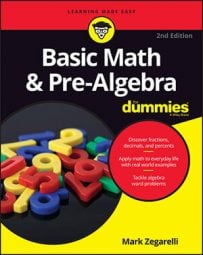Converting a decimal to a fraction is pretty simple. The only tricky part comes in when you have to reduce the fraction or change it to a mixed number.
Doing a basic decimal-to-fraction conversion
Here's how to convert a decimal to a fraction:
Draw a line (fraction bar) under the decimal and place a 1 underneath it.
Suppose you want to turn the decimal 0.3763 into a fraction. Draw a line under 0.3763 and place a 1 underneath it:

This number looks like a fraction, but technically it isn't one because the top number (the numerator) is a decimal.
Move the decimal point one place to the right and add a 0 after the 1.

Repeat Step 2 until the decimal point moves all the way to the right so you can drop the decimal point entirely.
In this case, this is a three-step process:

As you can see on the last step, the decimal point in the numerator moves all the way to the end of the number, so dropping the decimal point is okay.
Moving a decimal point one place to the right is the same thing as multiplying a number by 10. When you move the decimal point four places in this problem, you're essentially multiplying the 0.3763 and the 1 by 10,000. Notice that the number of digits after the decimal point in the original decimal is equal to the number of 0s that end up following the 1.
Getting mixed results
When you convert a decimal greater than 1 to a fraction, the result is a mixed number. Fortunately, this process is easy because the whole number part is unaffected by the conversion. So focusing only on the decimal part, follow the same steps I outline in the preceding section.
For example, suppose you want to change 4.51 to a fraction. The result will be a mixed number with a whole number part of 4. To find the fractional part, follow these steps:
Draw a line (fraction bar) under the decimal and place a 1 underneath it.
Draw a line under 0.51 and place a 1 underneath it:

Move the decimal point one place to the right and add a 0 after the 1.

Repeat Step 2 until the decimal point moves all the way to the right so you can drop the decimal point entirely.
In this case, you have only one additional step:

So the mixed-number equivalent of 4.51 is


